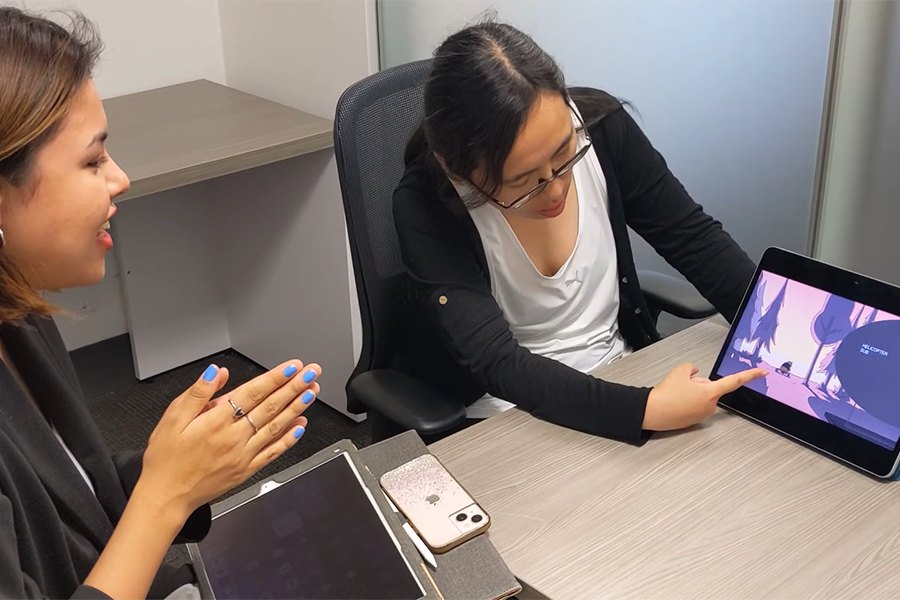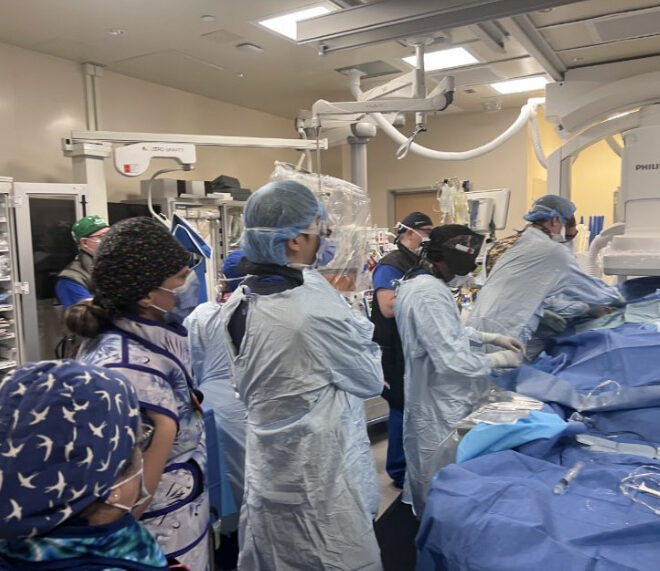
Members of the team of co-developers of the animated short film, Rachel Corston, (L), and Beatrice Chen, discussing the project.
Augusta Lipscombe
Animation on Cree community heart health hits the big screen
The collaborative teams from Weeneebayko Area Health Authority (WAHA) and the Ted Rogers Centre for Heart Research at UHN’s Peter Munk Cardiac Centre have been selected to showcase their animated short film on First Nations’ heart health at the 2024 Toronto Shorts International Film Festival.
The film, Strengthening our Hearts through a River of Possibilities, is set in the communities of Moosonee and Moose Factory, Ont., gateway to the Arctic and traditional territory of the Moose Cree people.
It highlights key themes from community members’ stories about managing their heart health, including difficulties accessing specialized care close to home and being offered treatment plans that respect their cultural values. Despite these challenges, the resilience of these communities transcends throughout the animation, underscoring the importance of relationships with family, the land and one’s emotional, mental, and spiritual health.
“The animation was informed by sharing circles with community members, which provided insight into the unique experience of patients in the region,” says Justice Seidel, Community Relations Consultant for the project and a medical student at the Northern Ontario School of Medicine University in Thunder Bay.
“It’s an opportunity to share these findings with community members — and a wider audience — in a way that’s representative of Cree culture.”
For centuries, Moose Factory has been a gathering site for Indigenous and non-Indigenous peoples within the region. Although communities in the region each have their own unique histories, they are all connected by the importance they place on the relationships they have with their people and their land.
While the remoteness of each community has made access to specialized health care challenging, the Cree people of western James Bay and Hudson Bay live with resiliency — paving the way for a healthier future for themselves and generations to come.
Hopeful for community-driven care solutions that can bridge the unique worldviews of Western health care and Indigenous communities, Strengthening our Hearts through a River of Possibilities emphasizes the role digital innovation plays in bringing holistic health care closer to home, particularly through the clinical partnership between UHN’s Peter Munk Cardiac Centre and WAHA, and the use of UHN-developed Medly — an app that remotely connects more than 70 WAHA patients to their medical team.
This selection by the film festival, which ran Aug. 22 to Aug. 25, recognizes how the ongoing clinical and research partnership between WAHA and the Peter Munk Cardiac Centre can support culturally safe care using both a First Nations’ and Western worldview of healing.
WAHA is a regional, community-focused organization, committed to providing optimum health care as close to home as possible for a population of more than 12,000 people living along the western James Bay and Hudson Bay coasts.
TRANSFORM HF is an Institutional Strategic Initiative created in joint support and partnership with the University of Toronto and the Ted Rogers Centre for Heart Research (TRCHR). It is co-led by Drs. Heather Ross, Division Head of Cardiology at Peter Munk Cardiac Centre, and Craig Simmons, Distinguished Professor of Mechanical and Industrial Engineering at the University of Toronto.
The film was co-developed by Rachel Corston, a Sheridan College animation student from Moose Cree First Nation; Beatrice Chen, a graduate student in U of T’s master of biomedical communications program; Janice Cheng, a Vancouver Institute of Media Arts alumnus; Elder Greg Spence, Director of Community Relations with WAHA; Justice Seidel; and Dr. Sahr Wali, a scientific associate at UHN and TRCHR.
It builds on findings from community-based research supported by a partnership between WAHA and UHN.
Recognizing the value of culture and community, Strengthening our Hearts through a River of Possibilities features symbolic animal characters, real-life locations and Cree metaphors to capture the realities of living in remote communities with heart conditions and the need for culturally safe care.
“Portraying a community issue in a positive and light-hearted way is a step in the right direction,” says Rachel. “I’m really glad I got to use my artistic skills and be a big part of making our animated film.”

